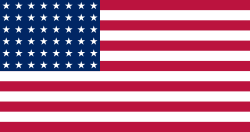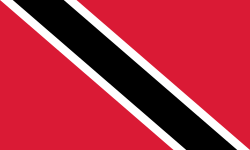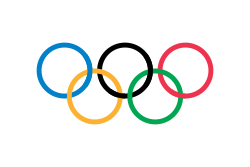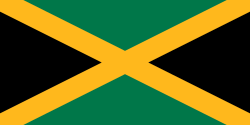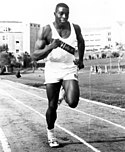Bob Hayes
| Bob Hayes | |
|---|---|
 | |
| Osobní informace | |
| Narození | 20. prosince 1942 Jacksonville |
| Úmrtí | 18. září 2002 (ve věku 59 let) Jacksonville |
| Stát | |
| Výška | 183 cm |
| Kariéra | |
| Disciplína | 100 m |
| Účasti na LOH | 1964 |
| Některá data mohou pocházet z datové položky. | |
| Přehled medailí | ||
|---|---|---|
| zlato | LOH 1964 Tokio | běh na 100 m |
| zlato | LOH 1964 Tokio | štafeta 4×100 m |
[1]Robert Lee „Bob“ Hayes (20. prosince 1942 Jacksonville, Florida – 18. září 2002 Jacksonville, Florida) byl americký atlet, sprinter, dvojnásobný olympijský vítěz.
Sportovní kariéra
Hayes jako malý běhal se svým bratrem Ernestem, který trénoval na boxéra. Studoval na střední škole Matthewa W. Gilberta v Jacksonville, a tam hrál Hayes za fotbalový tým. V letech 1660-1664 studoval na Floridské zemědělské a mechanické univerzitě. V roce 1962 vytvořil světový rekord v běhu na 100 yardů časem 9,2, který o rok později ještě vylepšil na 9,1. Jako první člověk na světě zaběhl trať 60 yardů v hale pod 6 sekund (5,9). Na olympiádě v Tokiu v roce 1964 zvítězil v běhu na 100 metrů časem 10,0 (elektronicky 10,05). Byl také členem vítězné štafety USA na 4 x 100 metrů, která v olympijském finále vytvořila nový světový rekord časem 39,0. Krátce po olympiádě ukončil atletickou kariéru a stal se hráčem amerického fotbalu. Od roku 1965 Hayes začal hrát profesionálně fotbal jako široký přijímač pro Dallas Cowboys, po dobu 10 sezón. S Cowboys vyhrál v roce 1972 Super Bowl.
V letech 1962 až 1964 mu byla vypočítána rychlost 11,4 až 12,0 m/s (41,0 až 43,2 km/h), což byl tehdejší neoficiální rychlostní rekord v lidském sprintu.[2]
Odkazy
Reference
- ↑ Bob Hayes | American athlete. Encyclopedia Britannica [online]. [cit. 2020-12-14]. Dostupné online. (anglicky)
- ↑ SOCHA, Vladimír. Vývoj rychlosti lidského sprintu. OSEL.cz [online]. 20. července 2018. Dostupné online. (česky)
Externí odkazy
 Obrázky, zvuky či videa k tématu Bob Hayes na Wikimedia Commons
Obrázky, zvuky či videa k tématu Bob Hayes na Wikimedia Commons - Bob Hayes na stránkách Světové atletiky (anglicky)
- Bob Hayes v databázi Olympedia (anglicky)
Média použitá na této stránce
Olympic Rings without "rims" (gaps between the rings), As used, eg. in the logos of the 2008 and 2016 Olympics. The colour scheme applied here was specified in 2023 guidelines.
Olympic Rings without "rims" (gaps between the rings), As used, eg. in the logos of the 2008 and 2016 Olympics. The colour scheme applied here was specified in 2023 guidelines.
US Flag with 44 stars. In use 4 July 1891–3 July 1896. Created by jacobolus using Adobe Illustrator, and released into the public domain.
US Flag with 45 stars. In use 4 July 1896–3 July 1908. Created by jacobolus using Adobe Illustrator, and released into the public domain. This flag was used during the Spanish-American War.
US Flag with 45 stars. In use 4 July 1896–3 July 1908. Created by jacobolus using Adobe Illustrator, and released into the public domain. This flag was used during the Spanish-American War.
US Flag with 46 stars. In use 4 July 1908–3 July 1912. Created by jacobolus using Adobe Illustrator, and released into the public domain.
Other version: Image:US 46 Star Flag.svgUS Flag with 48 stars. In use for 47 years from July 4, 1912, to July 3, 1959.
The Canadian Red Ensign used between 1921 and 1957.
This image has compared for accuracy (mainly colors) using an image from World Statesmen. The only change is making the maple leaves green from red. This image has compared for accuracy (mainly colors) using an image from World Statesmen. The most recent version of this image has changed the harp into one with a female figure; see [http://flagspot.net/flags/ca-1921.html FOTW
(c) I, Cmapm, CC BY-SA 3.0
The flag of the Soviet Union (1955-1991) using a darker shade of red.

(c) I, Cmapm, CC BY-SA 3.0
The flag of the Soviet Union (1955-1991) using a darker shade of red.

Olympijská vlajka
Flag of Jamaica. “The sunshine, the land is green, and the people are strong and bold” is the symbolism of the colours of the flag. GOLD represents the natural wealth and beauty of sunlight; GREEN represents hope and agricultural resources; BLACK represents the strength and creativity of the people. The original symbolism, however, was "Hardships there are, but the land is green, and the sun shineth", where BLACK represented the hardships being faced.
Local call number: RC02964
Title: FAMU athlete Robert Hayes practices running on the track: Tallahassee, Florida
Date: March 15, 1962
Accompanying note: "Hayes Will Try for World Mark--Florida A & M University's rapid Robert Hayes, who unofficially tied the world mark for the 100-yard dash at 9.2 just a month ago at Miami, tunes up on the track here and will be gunning to lower the official 9.2 record held by Villanova's Frank Budd. Hayes, 19, and a sophomore, will be running Saturday, Mar. 17, on the same track at University of Miami, where he ran his 9.2 and officials there say the track will be even faster as the measured straightway has been groomed daily."
Physical descrip: 1 photoprint - b&w - 10 x 8 in.
Series Title: Reference collection
Repository: State Library and Archives of Florida, 500 S. Bronough St., Tallahassee, FL 32399-0250 USA. Contact: 850.245.6700. Archives@dos.state.fl.us
Persistent URL: www.floridamemory.com/items/show/26679
Visit Florida Memory to learn more about the history of college football in Florida.Visit Florida Memory to find resources for Black History Month and to learn about the contributions of African-Americans in Florida history.
US Flag with 46 stars. In use 4 July 1908–3 July 1912. Created by jacobolus using Adobe Illustrator, and released into the public domain.
Other version: Image:US 46 Star Flag.svgUS Flag with 44 stars. In use 4 July 1891–3 July 1896. Created by jacobolus using Adobe Illustrator, and released into the public domain.
Flag of the unified Team of Germany for the Olympic Games, 1960–1968.






